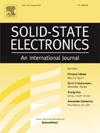Reactive sputtering deposited α-MoO3 thin films for forming-free resistive random-access memory
IF 1.4
4区 物理与天体物理
Q3 ENGINEERING, ELECTRICAL & ELECTRONIC
引用次数: 0
Abstract
In this study, α-MoO3 thin films were prepared on single-side polished (1 0 0) silicon substrates using radio-frequency reactive sputtering. By adjusting the substrate temperature and oxygen proportion, α-MoO3 thin films with desirable crystal phase and surface morphology were successfully grown. The substrate temperature exceeded 400℃ and the oxygen proportion of 50 % are essential for the deposition of a single-phase polycrystalline α-MoO3 film with abundant oxygen vacancies. A resistive random-access memory (RRAM) device fabricated by the as-prepared α-MoO3 film exhibited stable resistive switching characteristics with a forming-free behavior, achieving set/reset voltages below 0.3 V, a cycling durability over 250 cycles and an ON/OFF ratio of 102. Furthermore, I-V curve fitting analysis revealed a trap-controlled electron conduction mechanism in the RRAM device, where the high-resistance state exhibited a space-charge-limited current (SCLC) conduction mode. This study demonstrates the significant potential of radio-frequency reactive sputtering for fabricating functional materials for the application of electronic devices.
反应溅射沉积α-MoO3薄膜用于无形成电阻随机存取存储器
本研究采用射频反应溅射技术在单面抛光(1 0 0)硅衬底上制备了α-MoO3薄膜。通过调节衬底温度和氧的比例,可以成功地生长出具有理想晶相和表面形貌的α-MoO3薄膜。衬底温度超过400℃,氧含量达到50%是制备具有丰富氧空位的单相多晶α-MoO3薄膜的必要条件。利用α-MoO3薄膜制备的电阻性随机存取存储器(RRAM)器件具有稳定的电阻开关特性,无形成行为,设置/复位电压低于0.3 V,循环耐久性超过250次,ON/OFF比为102。此外,I-V曲线拟合分析揭示了RRAM器件中陷阱控制的电子传导机制,其中高阻状态表现为空间电荷限制电流(SCLC)传导模式。这项研究证明了射频反应溅射在制造电子器件应用功能材料方面的巨大潜力。
本文章由计算机程序翻译,如有差异,请以英文原文为准。
求助全文
约1分钟内获得全文
求助全文
来源期刊

Solid-state Electronics
物理-工程:电子与电气
CiteScore
3.00
自引率
5.90%
发文量
212
审稿时长
3 months
期刊介绍:
It is the aim of this journal to bring together in one publication outstanding papers reporting new and original work in the following areas: (1) applications of solid-state physics and technology to electronics and optoelectronics, including theory and device design; (2) optical, electrical, morphological characterization techniques and parameter extraction of devices; (3) fabrication of semiconductor devices, and also device-related materials growth, measurement and evaluation; (4) the physics and modeling of submicron and nanoscale microelectronic and optoelectronic devices, including processing, measurement, and performance evaluation; (5) applications of numerical methods to the modeling and simulation of solid-state devices and processes; and (6) nanoscale electronic and optoelectronic devices, photovoltaics, sensors, and MEMS based on semiconductor and alternative electronic materials; (7) synthesis and electrooptical properties of materials for novel devices.
 求助内容:
求助内容: 应助结果提醒方式:
应助结果提醒方式:


